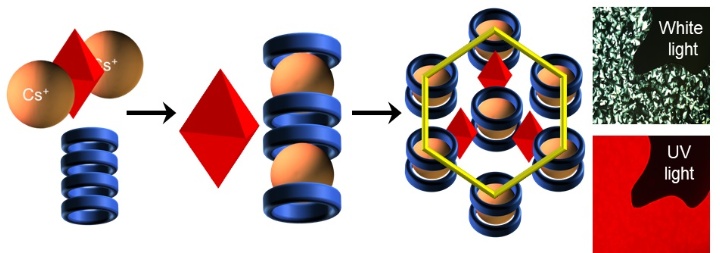Substitute for rare earth metal oxides

Embedding phosphorescent caesium metal clusters (red octahedrons) in organic liquid crystals (blue rings) produces hybrid nanomaterials that emit intense red light when irradiated with UV light. Photo: University of Stuttgart/ IOC
Nowadays energy conversion in lighting and optoelectronic devices requires the use of rare earth oxides.
However, due to their limited availability from natural resources located outside Europe rare earth oxides are considered as strategic minerals.
Therefore, alternative materials are highly desirable for energy efficient lighting and other applications.
Starting in January 2019 the Deutsche Forschungsgemeinschaft (DFG) and the French Agence Nationale de la Recherche (ANR) will be funding the Franco-German joint project SNAPSTER (Supramolecular nanomaterials containing phosphorescent transition metal clusters), which involves three research teams from the University of Stuttgart and the University of Rennes.
The aim of the SNAPSTER project is the integration of inorganic, phosphorescent metal clusters in organic liquid crystals via supramolecular interactions.
The liquid crystals are acting as isolating shell and improve the photophysical properties of the resulting hybrid materials and their chemical stability.
The emission wavelengths can be tailored by suitable choice of the metal cluster. SNAPSTER is based on the longstanding complementary expertise of the collaborating teams regarding organic material synthesis and characterization (Sabine Laschat, Stuttgart), inorganic cluster synthesis, photophysical characterization and preparation of hybrid materials (Yann Molard, Rennes) and the integration of these novel materials into electronic devices (Emmanuel Jacques, Rennes).
Sabine Laschat, Institut für Organische Chemie, Universität Stuttgart,
sabine.laschat@oc.uni-stuttgart.de
Media Contact
More Information:
http://www.uni-stuttgart.de/All latest news from the category: Life Sciences and Chemistry
Articles and reports from the Life Sciences and chemistry area deal with applied and basic research into modern biology, chemistry and human medicine.
Valuable information can be found on a range of life sciences fields including bacteriology, biochemistry, bionics, bioinformatics, biophysics, biotechnology, genetics, geobotany, human biology, marine biology, microbiology, molecular biology, cellular biology, zoology, bioinorganic chemistry, microchemistry and environmental chemistry.
Newest articles

Simplified diagnosis of rare eye diseases
Uveitis experts provide an overview of an underestimated imaging technique. Uveitis is a rare inflammatory eye disease. Posterior and panuveitis in particular are associated with a poor prognosis and a…

Targeted use of enfortumab vedotin for the treatment of advanced urothelial carcinoma
New study identifies NECTIN4 amplification as a promising biomarker – Under the leadership of PD Dr. Niklas Klümper, Assistant Physician at the Department of Urology at the University Hospital Bonn…

A novel universal light-based technique
…to control valley polarization in bulk materials. An international team of researchers reports in Nature a new method that achieves valley polarization in centrosymmetric bulk materials in a non-material-specific way…





















